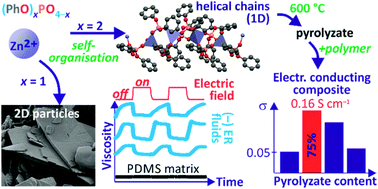1D and 2D hybrid polymers based on zinc phenylphosphates: synthesis, characterization and applications in electroactive materials†
Abstract
The synthesis, structure and properties of three hybrid polymers based on zinc arylphosphates are described in this study. Zinc bis(diphenylphosphate) (ZnDPhP) was obtained as needle-like crystals containing hexagonally packed, homochiral 1∞[Zn(DPhP)2/2] helical chains. The XRD and DSC studies revealed that upon heating, ZnDPhP undergoes a reversible thermal transition at ca. 160 °C with expansion mainly perpendicular to its c-axis. Zinc phenylphosphate hydrate (ZnMPhP-H) formed plate-like particles with an average thickness of less than 1 μm and much thinner nanolayers with a basal spacing of 15.5 Å. ZnMPhP-H was easily and reversibly dehydrated to its anhydrous form, ZnMPhP-A, which exhibited a somewhat larger basal spacing of 16.5 Å and the capacity for amine intercalation. The thermal decomposition of ZnDPhP or ZnMPhP-A began around 250 °C, resulting in the formation of solid mixtures of zinc phosphates and electron-conducting carbonaceous phases. The bulk electrical conductivities of the poly(vinylidene fluoride)-based composites containing the ZnDPhP pyrolyzates reached 0.1–0.2 S cm−1. Upon mixing with silicone oil, all the synthesized hybrid polymers formed fluids that exhibit significant negative electrorheological effects and have potential for application in electroresponsive smart materials. The application of an electric field during the crosslinking of such systems affected the viscoelastic properties of the resultant solid composites, while the cured systems showed rather small electrorheological effects.



 Please wait while we load your content...
Please wait while we load your content...